Enjoy slow-simmered Pakistani nihari with succulent beef shanks spiced with homemade nihari masala. Like soothing beef paya soup, Pakistani beef stew is hearty and filling – making it a perfect cozy meal for the cooler winter months. Don’t forget the homemade naan to soak up all the delicious flavors. And once you’ve made this recipe with beef, try mutton nihari next.

Why You’ll Love this Recipe
My family loves the authentic but easy beef nihari recipe we make at home for house guests, special occasions (like Eid), or when my son, husband, or father-in-law requests it.
- You can prepare the easy one-pot meal on the stovetop or Instant Pot.
- There is no need for extra steps because this is a straightforward homestyle recipe you can elaborate on if you want to or whip up as a filling weeknight meal.
- It may be a simple version of the meal, but I don’t sacrifice flavor – it’s delicious, and you can find it listed as one of my favorite meals in my about me.
What is Nihari?
Nihari, the national dish of Pakistan, is a perfect comfort dish for any dawat or gathering. The festive beef shank stew consists of tender meat tempered with sautéed garlic, ginger, and freshly ground whole spices, and it is famous throughout the Indian subcontinent.
The word ‘nihari’ comes from the Arabic word ‘nahaar,’ which means early morning – referring to the time of day the meal is served most often in homes.
A Brief History of Nihari
Nihari originated in India during the Mughal era. The meal was traditionally prepared by slow-cooking the shank meat and bone marrow overnight with spices so the dish would be ready to serve after morning prayer.
When the Mughal empire spread, the recipe for nihari traveled too. It became popular in places like Hyderabad, Lahore, and other parts of present-day India, Pakistan, and Bangladesh. Even today, it remains a hallmark of Mughlai and Pakistani cuisine.
What You Need to Make this Recipe
- Nihari Masala: I prefer to use a homemade nihari spice blend. Ours features sautéed ginger and garlic that cooks with warm spices like ground coriander seeds, ginger, red chili powder, ground cumin seeds, turmeric powder, fennel seeds, and salt. If you are short on time, use a ready-made spice mix; you can find it online or at your local Asian or Indian market. My favorite is Shan Nihari Masala, and I use about ¼ of the packet for mild, and more if you prefer a spicier beef nihari.
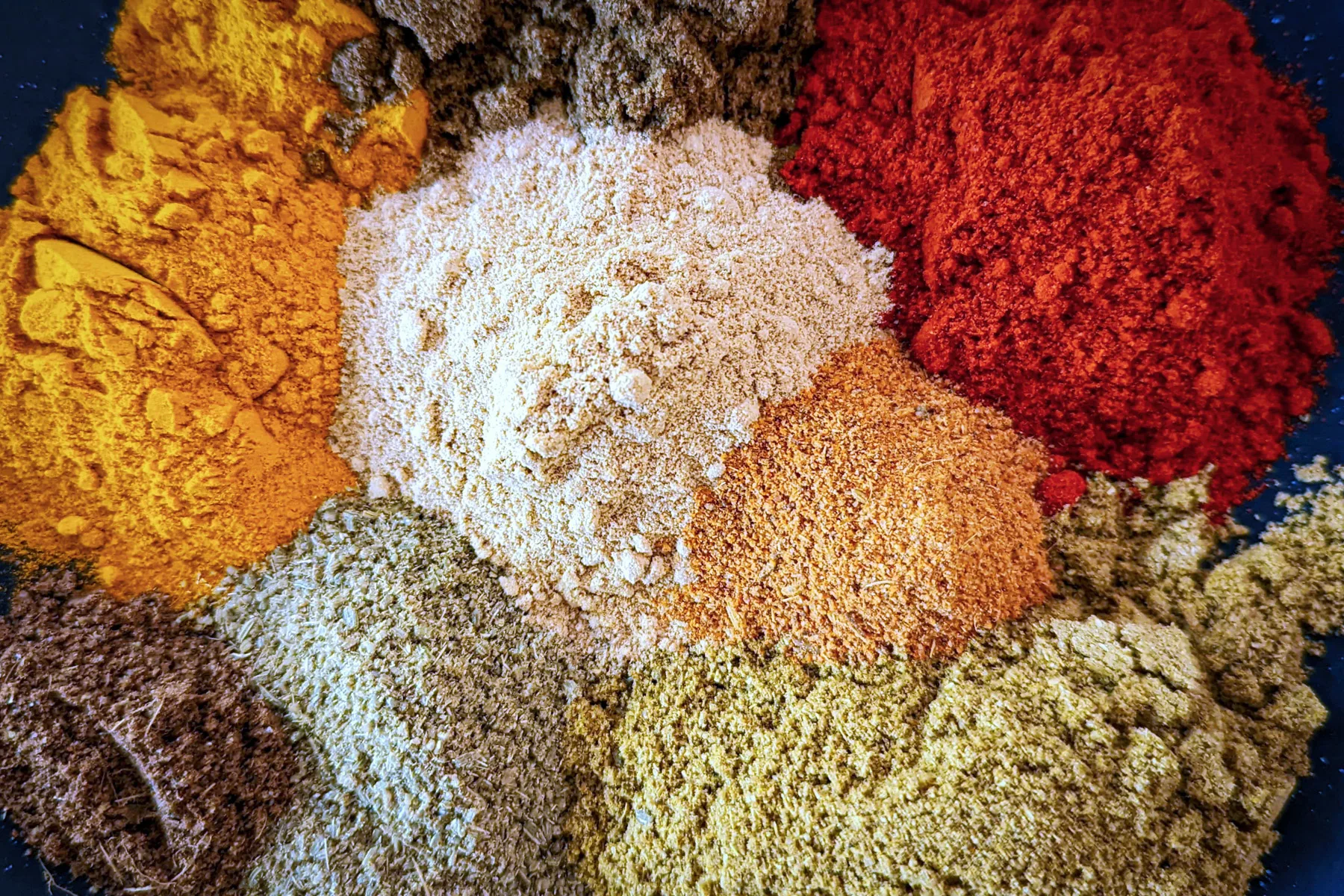
- Beef: Beef shanks stew or pressure cook until it is fall-off-the-bone tender. Set aside enough cooking time for the collagen and tissues to break down and incorporate with the broth.
- Bones: What is nihari without shank bones? The shank portion of the beef containing bone marrow adds gelatin and fat to make the stew savory and delicious. Some versions, like paya nihari, use trotters to make the stew.
- Garnish: Fresh toppings are a must-have, whether you’re eating at home or in a restaurant. We serve ours with caramelized onions, fresh ginger, green chilies, and lemon wedges.
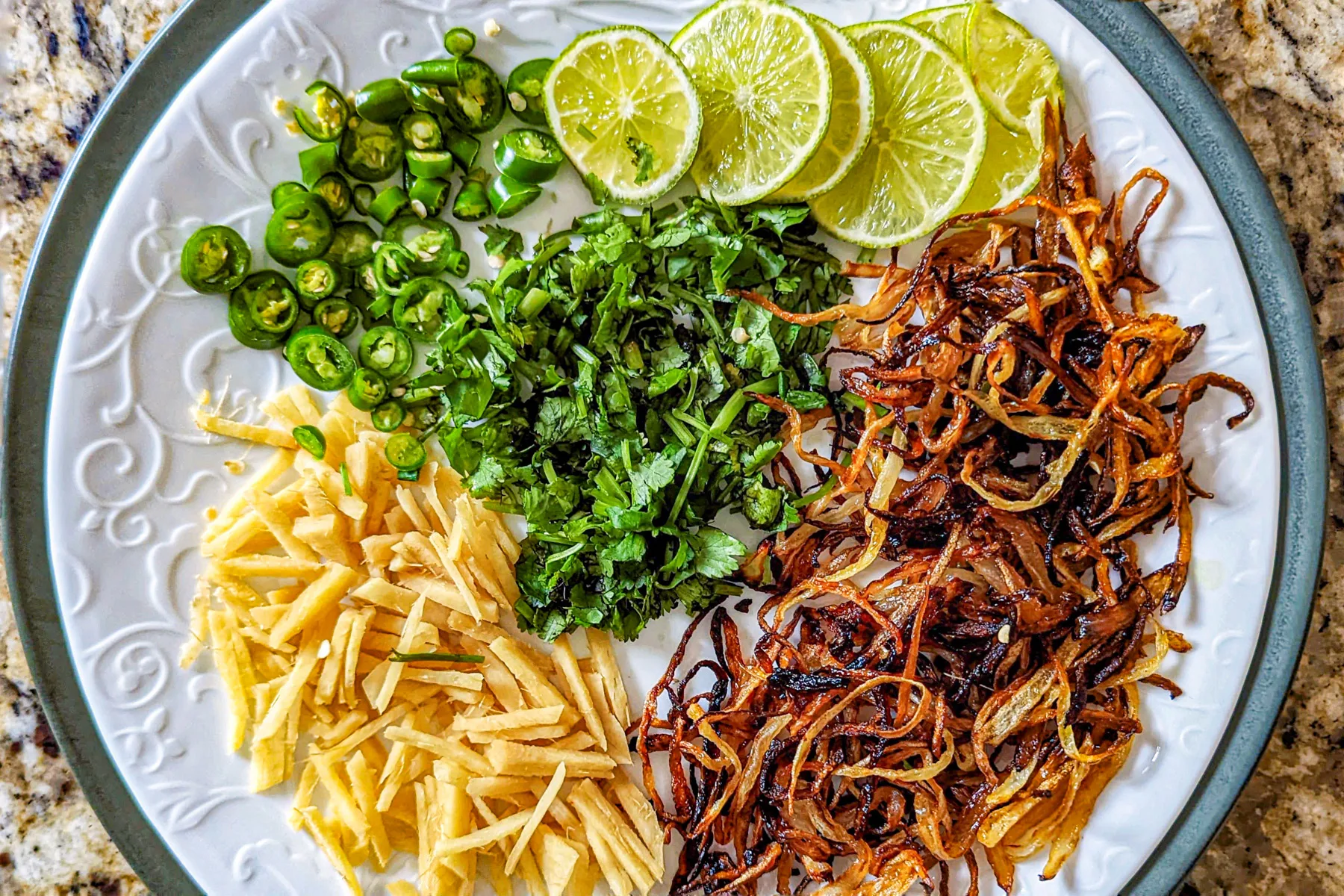
Additions and Substitutions
- Protein: Replace the beef in this recipe with beef or mutton trotters to make paya nihari. Nalli nihari is another favorite in our home, using beef, lamb, or goat meat on the shank. You can also make chicken nihari or use boiled dal as a vegetarian option.
- Spices: I enjoy the flavor of our homemade masala, but if you want a tangy option, consider including raw or powdered mango to make aam ki nihari.
How to Make Beef Nihari
The full recipe with measurements is in the recipe card below.
Step 1: Warm ghee in a Dutch oven over medium heat. Add the onion and fry until caramelized and brown, for about 20-25 minutes. Remove half of the caramelized onions using a slotted spoon and set them aside. Stir the garlic and ginger into the pot and cook for another minute.
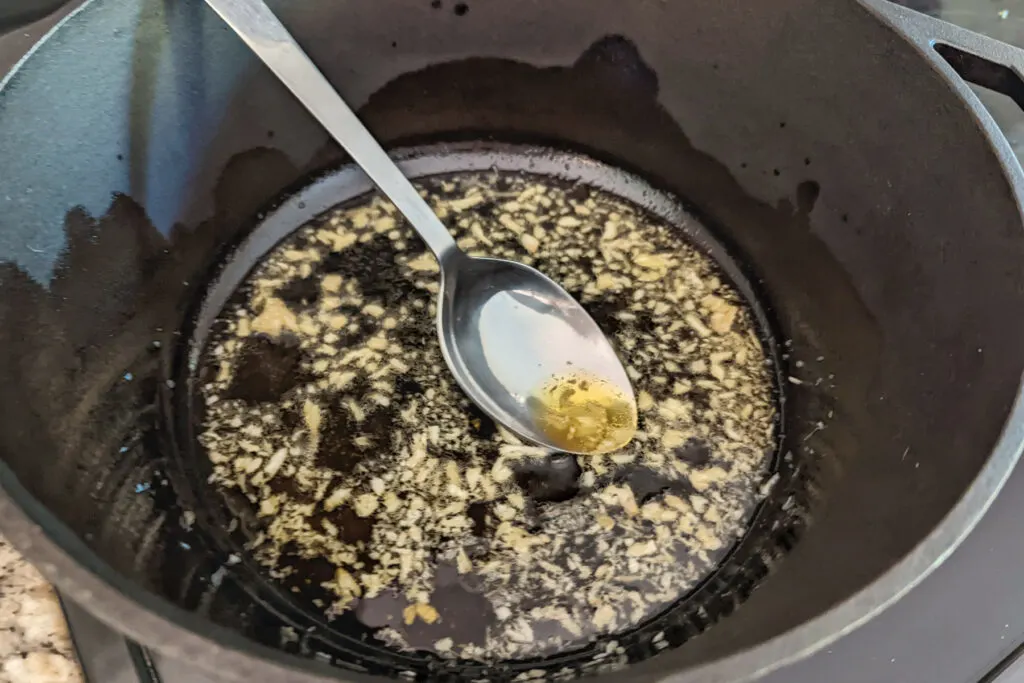
Step 2: Add the coriander powder, ginger powder, red chili powder, cumin, turmeric, fennel, and salt; stir to combine.
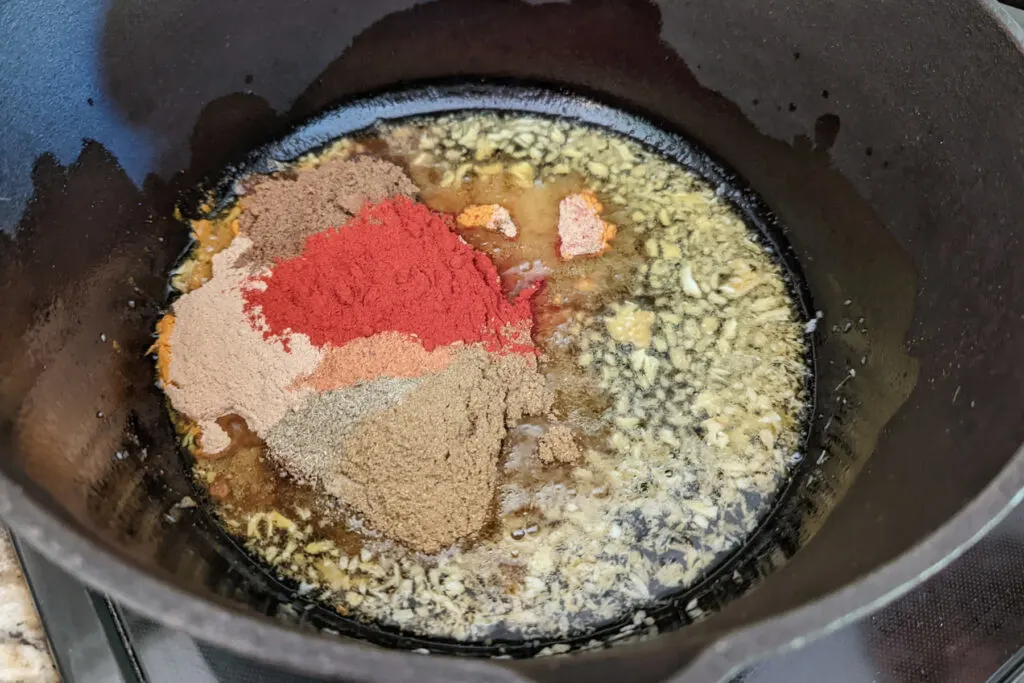
Step 3: Rinse the beef shank and bones, and add them to the pot. Fry for 5 minutes until the color changes. Then, add 4-6 cups of water (or enough water to cover the beef).
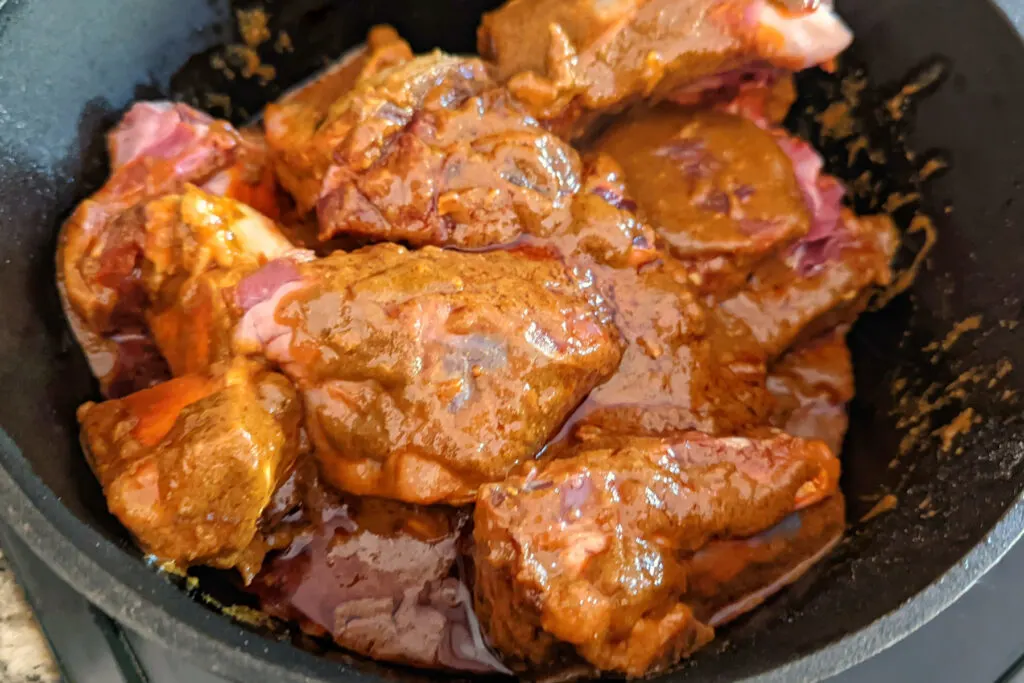
Step 4: Bring the pot to a boil, then reduce the heat to low. Cover and cook for 4 hours.
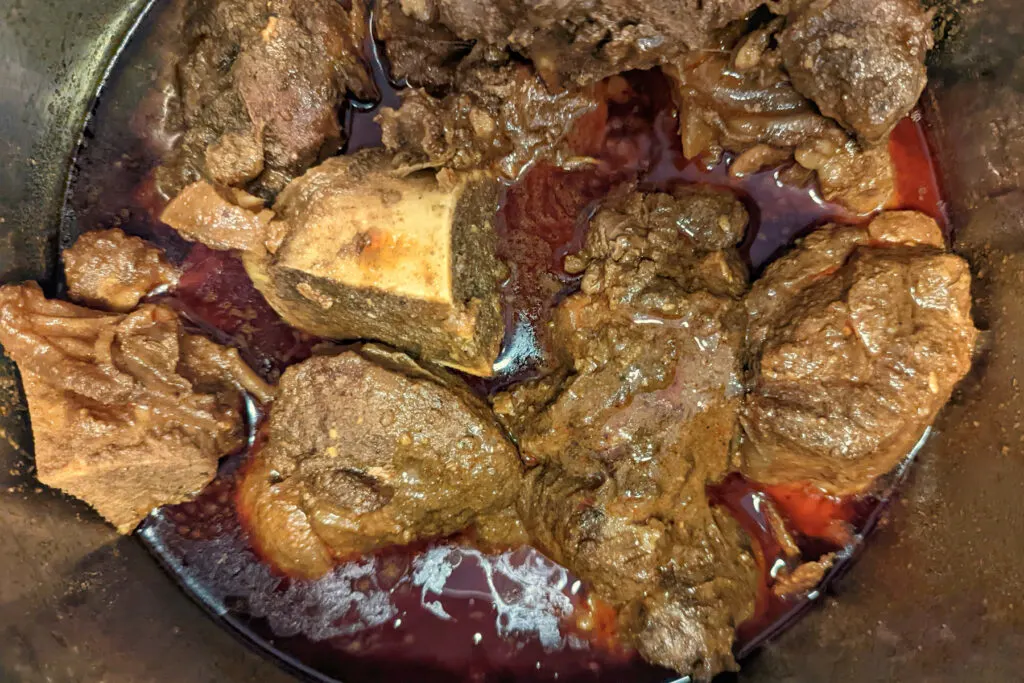
Expert Tips
- Setting aside at least four hours to slow-cook the beef on the stovetop is essential for good nihari and for the shank meat to become tender.
- Enhance the dish’s flavor by frying the beef shanks before adding the water and braising them.
- I keep my recipe gluten-free out of personal preference, but if you enjoy a thicker authentic nihari, toast 1 cup of atta flour (whole wheat flour or Durum flour) in a skillet. You can also use chickpea flour. Combine the toasted flour mixture with 1 cup of warm water and slowly add it to the pot after the meat has finished cooking to thicken the masala and give it a nice brown color. You should not add it all at once. Instead, stir in a little at a time until you get the consistency and flavor you desire.
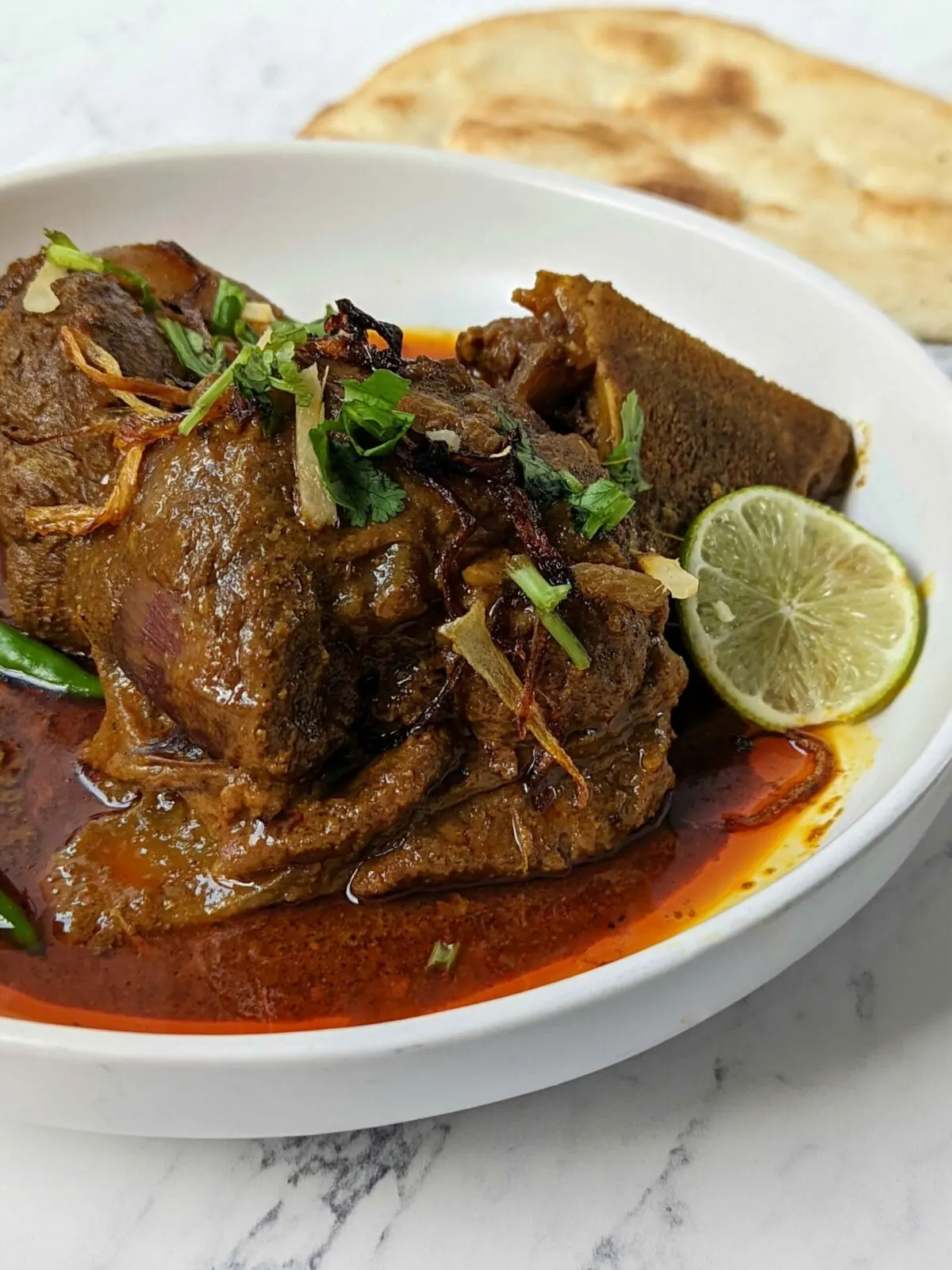
Serving Suggestions
Enjoy the hearty beef stew any time of the day, specifically for breakfast, but let your heart decide. And whatever time of day you choose, bread like naan, sheermal, paratha, or chapati is a popular choice to serve with the stew. Sometimes, our family likes to splurge and eat it with carrot halwa or another tasty dessert for special occasions.
Plating plays a role in the nihari experience. Arrange the beef shanks in a shallow bowl and spoon the masala around it. Drizzle the oil (tari) over the top and garnish with the reserved onions, fresh ginger, cilantro, and green chilies.
What to do With the Leftovers
- Refrigerate – Store the leftovers in an airtight container for 3-4 days.
- Freeze – Let the dish cool and transfer it to a freezer-safe container or bag. It will freeze for 3-4 months.
- Thaw – Defrost the beef in the refrigerator overnight.
- Reheat – Warm the leftovers on the stovetop or microwave, and enjoy!
Frequently Asked Questions
What is nalli nihari?
Nalli nihari refers to bones with marrow that stew with the beef or lamb shanks. The bones provide a richness that deeply flavors the broth. After hours of cooking you can suck the marrow out of the bones like my family often does or push it out once it’s cooked and incorporate it into the masala.
What cut of meat do you use for nihari?
Make traditional nihari, a staple in Pakistani cuisine, with bone-in beef shank, mutton, chicken, or lamb. Another prominent feature is the nalli or marrow bones that richly flavor the stew.
What does nihari taste like?
The beef is tender and succulent after slow cooking in a buttery, rich masala. My family’s recipe is mild compared to the popular street food served in restaurants in Karachi and Lahore that my mother-in-law calls tear-inducing. However, the warmly spiced gravy with gentle heat and filling beef creates a satiating comfort meal you’ll love.
What if this dish is too spicy?
Add two tablespoons of butter or yogurt at the end to cut some of the heat. You can also reduce the amount of red chili powder or replace it with Kashmiri chili powder (paprika).
Can I use garam masala?
While many delicious recipes use garam masala, nihari is not one of them. The toasted spice blend will not give you the full-bodied flavor you want. Instead, use the homemade masala in this recipe or purchase a store-bought masala if you don’t feel like collecting all the spices.
More Pakistani Recipes:

Easy Authentic Beef Nihari
- ½ cup ghee
- 2 large white onion, thinly sliced
- 1 inch ginger, minced
- 2 cloves garlic, minced
- 4 tablespoons coriander powder
- 4 tablespoons ginger powder
- 1½ tablespoon red chili powder
- 1 tablespoon ground cumin
- 3 teaspoons turmeric
- 3 teaspoons ground fennel
- 3 teaspoons kosher salt
- 3 pounds beef shank, bone-in, cut into 3-inch pieces
- 1 pound bones, with marrow
- 4-6 cups water
- 4 inch ginger, minced
- 1 cup cilantro, chopped
- 4 green chiles, finely diced
For the Stovetop:
- Heat ghee in a Dutch oven over medium. Add the onion and fry until caramelized and brown, for about 20-25 minutes. Remove half of the caramelized onions using a slotted spoon and set them aside. Stir the garlic and ginger into the pot and cook for another minute.
- Add the coriander powder, ginger powder, red chili powder, cumin, turmeric, fennel, and salt. Stir to combine.
- Rinse the beef shank and bones, and add them to the pot. Fry for 5 minutes until the color changes. Then, add 4-6 cups of water (or enough water to cover the beef).
- Bring the pot to a boil, then reduce the heat to low. Cover and cook for 4 hours.
- Remove the meat with a slotted spoon and set it aside. Then, remove the layer of oil (tari) accumulated at the surface and set it aside for plating.
For the Instant Pot:
- Heat ghee in an Instant Pot on saute mode. Add the onion and fry until caramelized and brown, for about 20-25 minutes. Remove half of the caramelized onions using a slotted spoon and set them aside. Stir the garlic and ginger into the pot and cook for another minute.
- Add the coriander powder, ginger powder, red chili powder, cumin, turmeric, fennel, and salt. Stir to combine.
- Rinse the beef shank and bones, and add them to the pot. Fry for 5 minutes until the color changes. Then, add 4-6 cups of water (or enough to cover the beef).
- Bring the pot to a boil on saute mode, then secure the lid and set it to manual high pressure for 45 minutes.
- Remove the meat with a slotted spoon and set it aside. Then, remove the layer of oil (tari) accumulated at the surface and set it aside for plating.
- Setting aside at least four hours to slow-cook the beef on the stovetop is essential for good nihari and for the shank meat to become tender.
- Enhance the dish’s flavor by frying the beef shanks before adding the water and braising them.
- I keep my recipe gluten-free out of personal preference, but if you enjoy a thicker authentic nihari, toast 1 cup of atta flour (whole wheat flour or Durum flour) in a skillet. You can also use chickpea flour. Combine the toasted flour mixture with 1 cup of warm water and slowly add it to the pot after the meat has finished cooking to thicken the masala and give it a nice brown color. You should not add it all at once. Instead, stir in a little at a time until you get the consistency and flavor you desire.
- The nutritional information shown is an estimate provided by an online nutrition calculator. It should not be considered a substitute for professional advice.


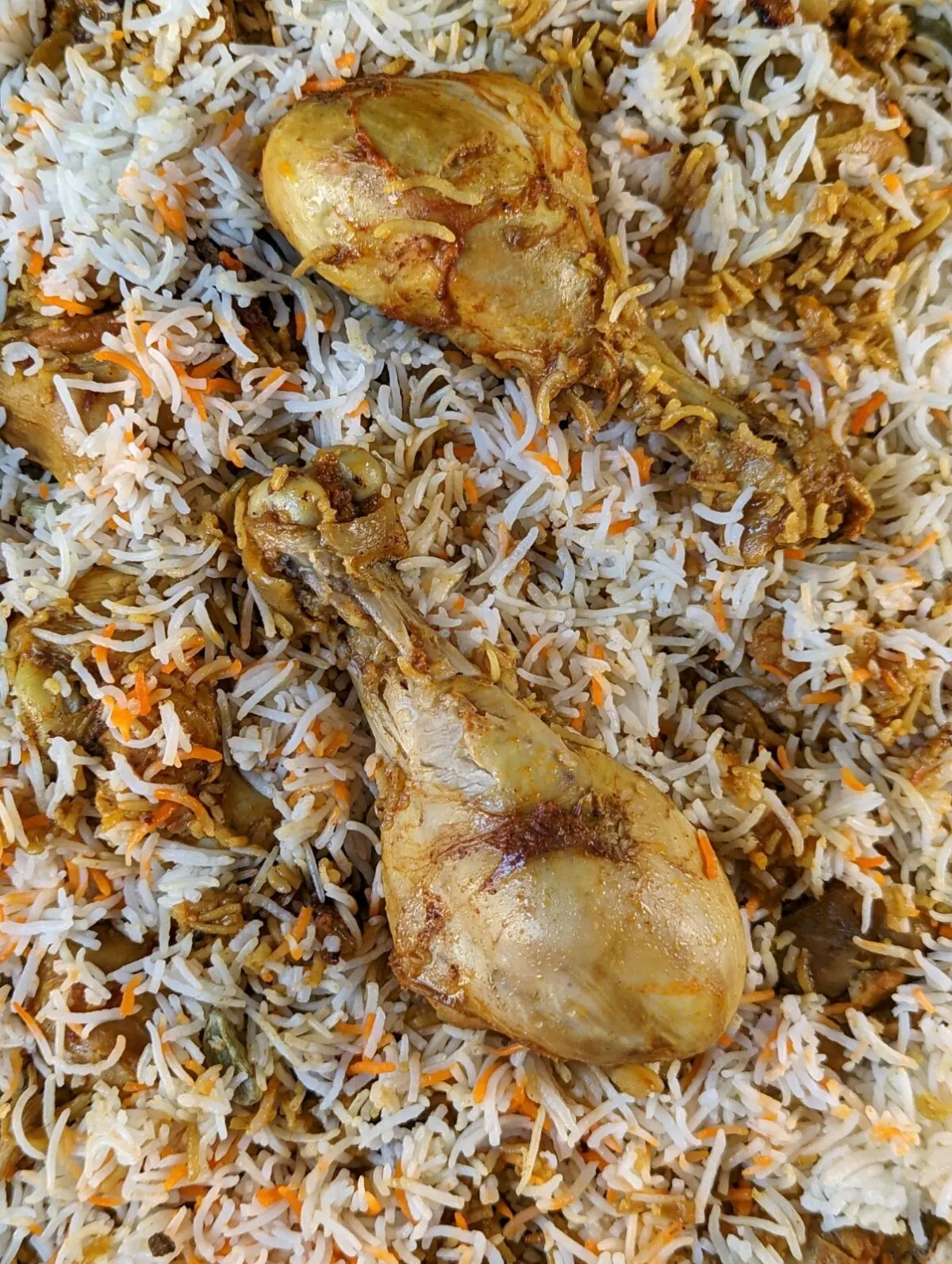
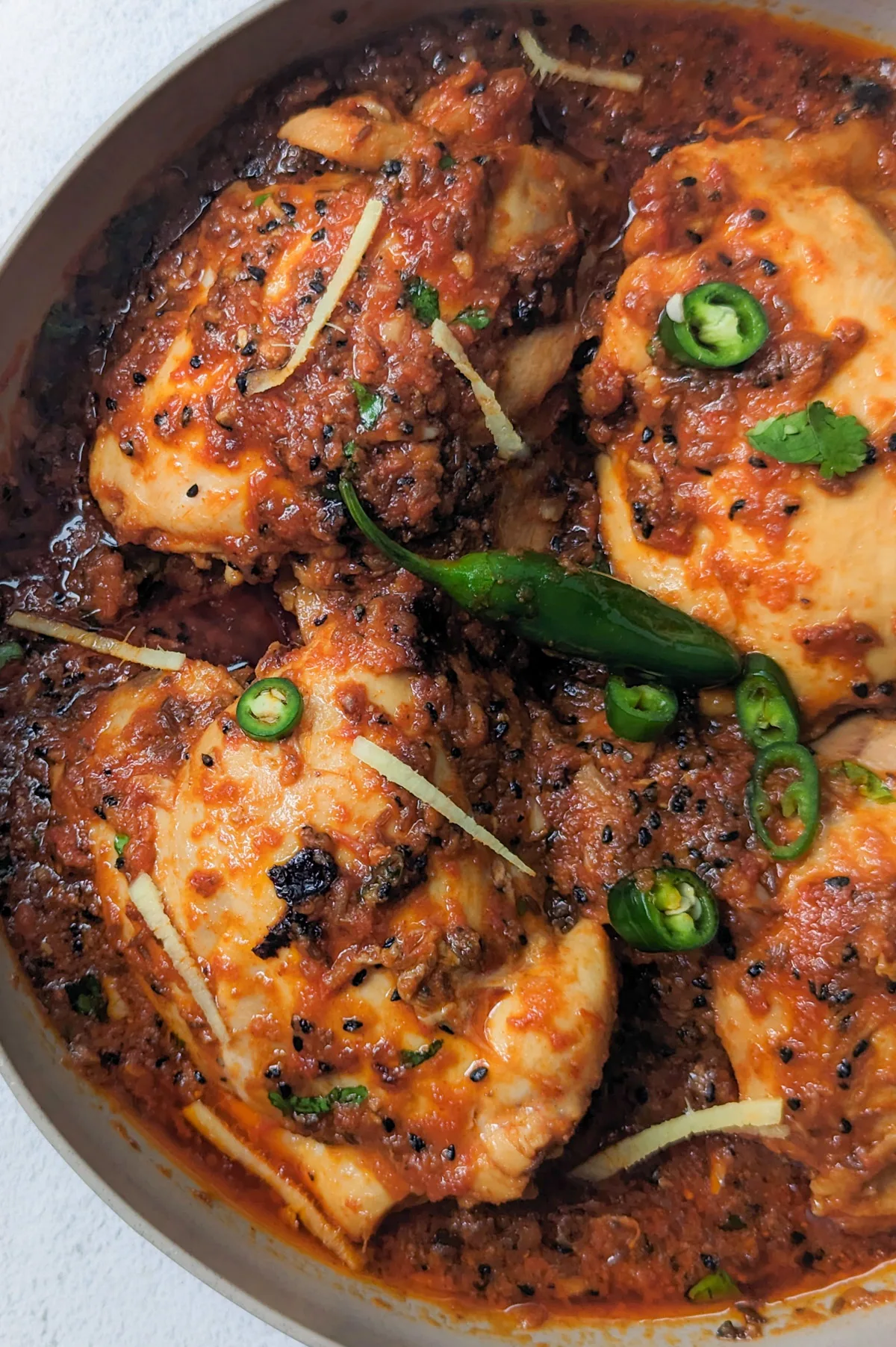
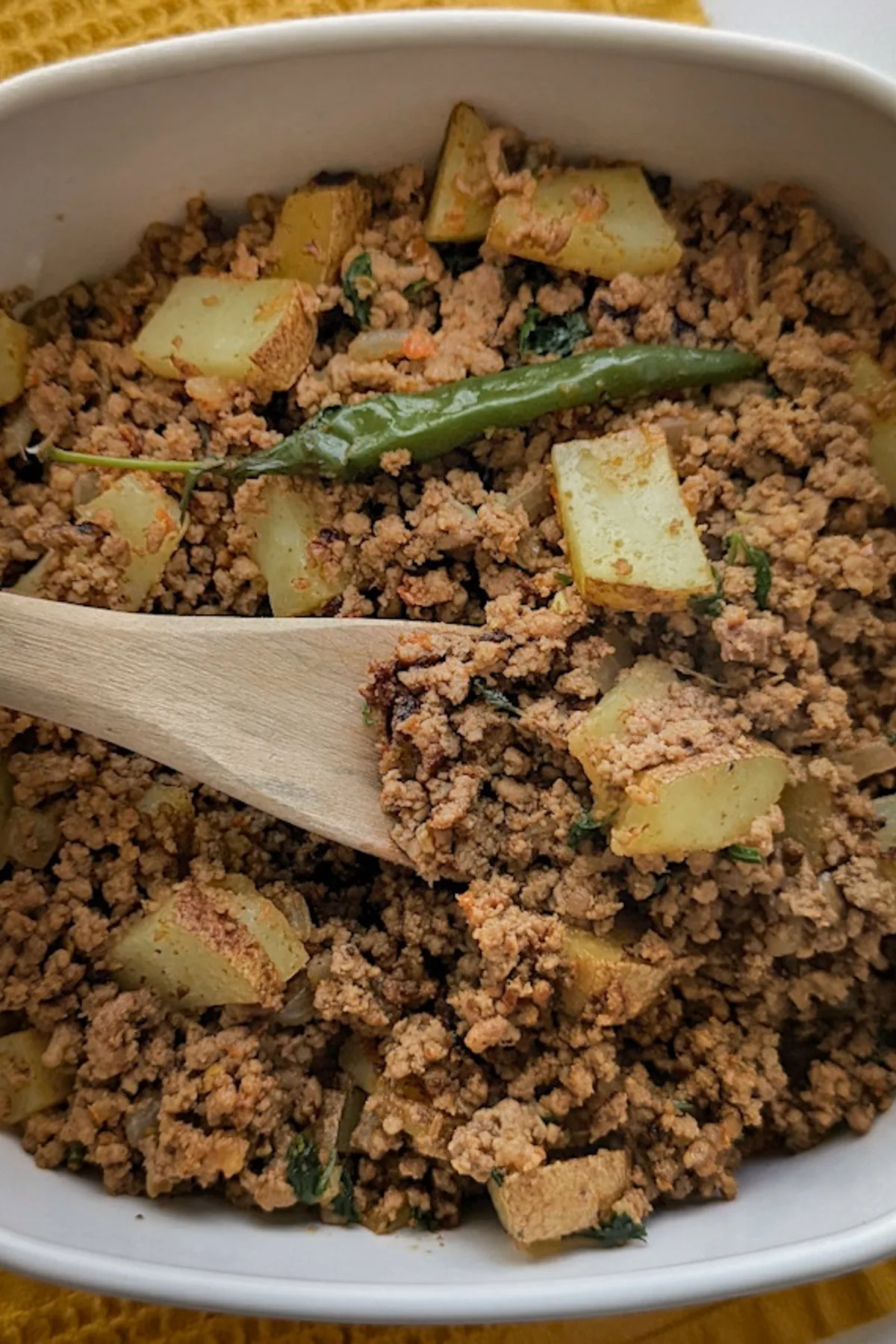
Alessandra
Monday 9th of October 2023
I’m a sucker for homemade masala. This is incredible!
Tressa Jamil
Monday 9th of October 2023
I am so happy you enjoyed it and didn't shy away from making the masala from scratch. Some people see all the spices and get freaked out, but it's so easy to make and flavorful.
Karishma
Monday 9th of October 2023
This looks incredibly comforting and flavorful! I can't wait to make it with my family soon!
Tressa Jamil
Monday 9th of October 2023
You'll have to come back and let me know what you think.
Ethan
Friday 26th of May 2023
Absolutely delicious! The flavors are rich and comforting. A must-try!
Tressa Jamil
Monday 9th of October 2023
I am glad this recipe was a win for you. Thank you for taking the time to leave a comment and rating!
Sara
Friday 26th of May 2023
Simply divine! A winter favorite.
Tressa Jamil
Monday 9th of October 2023
Yes, we love nihari in the winter. It's definitely one of those filling, stick-to-your-bones kind of meals.
Omar Khan
Wednesday 19th of April 2023
I love this recipe and it is now a regular at our Pakistani home! Even the kids love it. Comes out consistently the same.
Tressa Jamil
Monday 9th of October 2023
Your comment makes me so happy. I love knowing that our family recipe is a meal your family makes regularly; that is the reason I started the blog, to make meals that could bring people together.